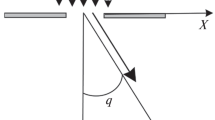Abstract
Fraunhofer diffraction patterns (spectra) of extended (in depth) asymmetric slit holes with absolutely absorbing inner faces and with different input (\(D\)) and output (\(D_{1}\)) apertures are calculated in the far field based on the model of equivalent diaphragms. The behavior of the spectrum of an extended object is studied analytically in the case of aperture differences \(2|\Delta|=|D_{1}-D|\) that are noticeably smaller than the size of the Fresnel zone \(\delta_{d}=\sqrt{\lambda d}\) (\(\lambda\) is the light wavelength and \(d\) is the hole depth). It is shown that in the range of angles \(|\theta|\ll\theta_{\text{cr}}=\sqrt{\lambda/d}\) the observed diffraction pattern of an extended object is equivalent to the diffraction of light on a flat slit (\(d=0\)) with an effective width \(D_{\text{eff}}=D+\Delta-\theta_{d}/(\sqrt{2}\pi)\). Based on a constructive approximation of the integral Fresnel function, the features of light diffraction on volumetric holes with noticeably different apertures are studied analytically: \(2|\Delta|\gg\delta_{d}\). Calculations show that in the cases of expanding (\(D_{1}>D\)) and narrowing (\(D_{1}<D\)) apertures, the behavior of the minima of the observed diffraction patterns in the ranges of angles \(|\theta|<|\theta_{\Delta}|=|\Delta|/d\) differs little from the equidistant behavior for a flat slit (\(d=0\)) of width \(D\) and \(D_{1}\), respectfully. The results can be used in the development of optoelectronic systems for dimensional inspection of perforated plates.









Similar content being viewed by others
REFERENCES
M. Born and E. Wolf, Principles of Optics (Pergamon Press, London, 1959).
J. W. Goodman, Introduction to Fourier Optics (McGraw-Hill, New York, 1968).
R. E. Vaganov and B. Z. Katselenbaum, Foundations of Diffraction Theory (Nauka, Moscow, 1982).
A. I. Potekhin, Certain Problems of Diffraction of Electromagnetic Waves (Sovetskoe Radio, Moscow, 1948).
P. Ya. Ufimtsev, Method of Edge Waves in Physical Diffraction Theory (Sovetskoe Radio, Moscow, 1962).
V. A. Borovikov and B. E. Kinber, Geometrical Theory of Diffraction (Svyaz’, Moscow, 1978).
H. Hönl, M. Maue, and K. Westpfahl, Theorie der Beugung (Springer-Verlag, Berlin, 1961).
B. E. Krivenkov and Yu. V. Chugui, ‘‘Fraunhofer Diffraction by bodies of constant thickness,’’ Avtometriya, No. 3, 79–92 (1987).
Yu. V. Chugui and B. E. Krivenkov, ‘‘Fraunhofer diffraction by volumetric bodies of constant thickness,’’ J. Opt. Soc. Am. A 6, 617–626 (1989). https://doi.org/10.1364/JOSAA.6.000617
Yu. V. Chugui, ‘‘Peculiarities of formation and delimitation of images of volume bodies in coherent light,’’ Avtometriya, No. 4, 103–112 (1991).
B. E. Krivenkov and Yu. V. Chugui, ‘‘Fraunhofer diffraction by reflective volumetric bodies of constant thickness,’’ Avtometriya, No. 4, 113–118 (1991).
Yu. V. Chugui, ‘‘Forming images of an asymmetric absolutely reflective edge of a 3D object in coherent light,’’ Optoelectron., Instrum. Data Process. 57, 311–322 (2021). https://doi.org/10.3103/S8756699021030080
Yu. V. Chugui, ‘‘Determination of geometric parameters of elongated objects of constant thickness by their diffraction patterns,’’ Avtometriya, No. 6, 76–92 (1991).
Yu. V. Chugui, ‘‘Diffraction phenomena by three-dimensional bodies of constant thickness and determination of their geometric parameters,’’ in 3D Laser Information Technologies, Ed. by P. E. Tverdokhleb (Ofset, Novosibirsk, 2003), pp. 428–479.
Yu. V. Chugui, ‘‘Fourier optics of 3D objects applied to dimensional inspection,’’ in Optical-information measuring and laser technologies and systems: Transactions of the Technological Design Institute of Scientific Instrument Engineering, Siberian Branch, Russian Academy of Sciences (Geo, Novosibirsk, 2012), pp. 15–42.
ACKNOWLEDGMENTS
The author is grateful to E.S. Arsenina for technical assistance.
Funding
The work was supported by the Ministry of Science and Higher Education of the Russian Federation (project no. AAAA-A17-117121270018-3).
Author information
Authors and Affiliations
Corresponding author
Ethics declarations
The author declares that he has no conflicts of interest.
Additional information
Translated by L. Trubitsyna
About this article
Cite this article
Chugui, Y.V. Diffraction Phenomena on Extended Asymmetric Slit with Absolutely Absorbing Inner Faces. Optoelectron.Instrument.Proc. 58, 43–54 (2022). https://doi.org/10.3103/S8756699022010022
Received:
Revised:
Accepted:
Published:
Issue Date:
DOI: https://doi.org/10.3103/S8756699022010022




